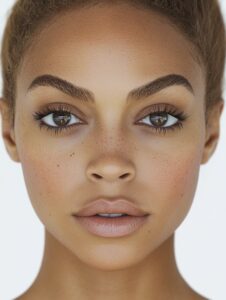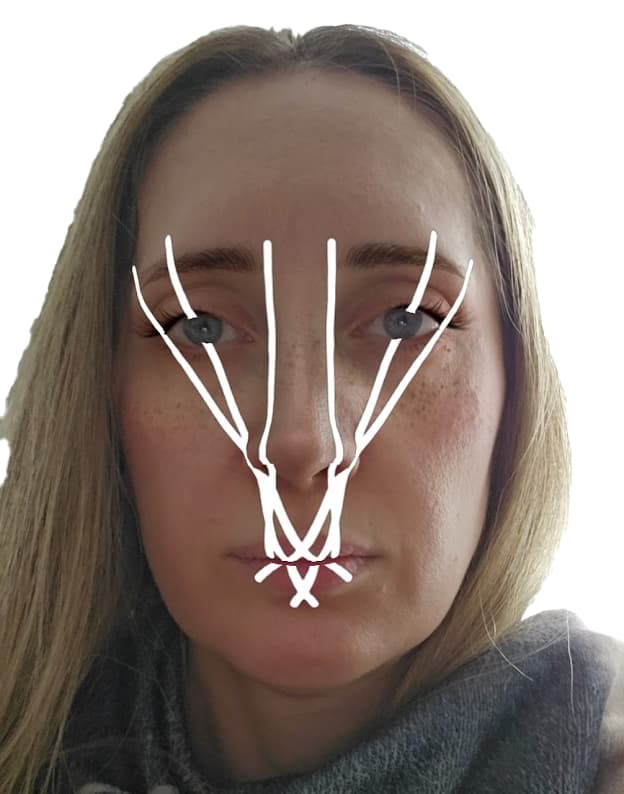Face Shape Analysis and Brow Mapping
Understanding face shapes is fundamental to achieving optimal brow design. Begin each service with a thorough analysis of your client’s facial structure and natural brow position. This initial step is crucial as it sets the foundation for the entire shaping process. Take time to observe the client’s features, bone structure, and existing brow shape. Consider factors such as forehead width, cheekbone prominence, and jaw definition to accurately determine the face shape.
Use the following mapping technique to create a customized blueprint for each client:
- Find the starting point: Align a straight tool vertically from the corner of the nose to the brow. This determines where the brow should begin, ensuring a balanced look that complements the nose and eyes.
- Locate the arch: Position tool from nose through pupil at a 45-degree angle. The arch is a critical point that can dramatically alter the expression and perceived face shape. Proper placement enhances the eyes and lifts the overall appearance.
- Determine endpoint: Align tool from nose corner past outer eye corner. This step ensures the brow tail doesn’t extend too far or end too abruptly, which can affect the perceived width of the face.
Remember that while these guidelines provide a starting point, each client’s features are unique. Be prepared to make subtle adjustments to achieve the most flattering result. Document your measurements and observations for future reference, as consistency is key in maintaining client satisfaction.
Shape-Specific Techniques
Oval Face

Oval faces are considered the most versatile for brow shaping due to their balanced proportions. When working with an oval face shape:
- Maintain a natural brow curve to complement the face’s soft contours. Avoid overly dramatic arches that can disrupt the natural harmony.
- Position the arch at approximately 2/3 from the brow start. This placement enhances the eyes without overpowering the face’s natural symmetry.
- Keep thickness consistent throughout the brow. This creates a polished look that frames the face without adding unnecessary angles.
For oval faces, consider incorporating brow lamination techniques to enhance the natural brow shape and add definition without altering the overall structure.
Square Face

Square faces benefit from brow shapes that soften angular features and create the illusion of length. When shaping brows for a square face:
- Create a defined arch to counterbalance the strong jawline. This adds a curved element to the face, softening the overall appearance.
- Extend the tail slightly to elongate the face visually. This technique draws the eye upward and outward, creating a more oval impression.
- Consider a slightly fuller brow to balance the strong facial features. This prevents the brows from appearing too thin against a broader face structure.
Brow lamination can be particularly effective for square faces, allowing for precise direction control and the creation of a softer, more lifted appearance.
Round Face

Round faces benefit from brow shapes that add definition and create the illusion of length. When working with a round face shape:
- Design a higher arch to add definition and create a more angular look. This helps to counteract the softness of the face’s curves.
- Keep brows angular rather than curved to introduce some structure to the face. Avoid rounded shapes that can emphasize the roundness of the face.
- Create a longer tail to elongate the face appearance. This draws the eye outward, making the face appear more oval.
Consider using a professional brow lamination kit to achieve a more structured look that can help define and sculpt the brows for round faces.
Heart-Shaped Face

Heart-shaped faces typically have a wider forehead tapering to a narrower chin. When shaping brows for this face shape:
- Keep the arch soft and rounded to balance the pointed chin. This helps to soften the overall facial features.
- Maintain moderate thickness throughout the brow to avoid overpowering the lower half of the face.
- Avoid excessive tapering at the tail, which can make the forehead appear wider. Instead, aim for a gentle taper that complements the face’s natural contours.
For heart-shaped faces, consider using professional tinting products to enhance the brow color and create a fuller appearance, particularly towards the tail end.
Professional Shaping Methods
Threading
Threading is an ancient technique that has gained popularity for its precision and ability to create clean lines. When using threading for brow shaping:
- Use a high-quality cotton thread for optimal control and comfort.
- Master the technique of twisting the thread to capture even fine, short hairs.
- Practice smooth, swift movements to minimize discomfort for the client.
- Use threading for creating crisp brow outlines and removing stray hairs around the brow area.
Threading is particularly effective for maintaining arch definition and creating sharp tail ends. It’s an excellent choice for clients with sensitive skin who may react to waxing.
Waxing
Waxing is efficient for bulk hair removal and can provide long-lasting results. When incorporating waxing into your brow shaping services:
- Choose between soft and hard wax based on the area and client’s skin sensitivity. Hard wax is generally preferred for the brow area as it adheres less to the skin.
- Always apply wax in the direction of hair growth to minimize breakage and ingrown hairs.
- Use small applicators for precise control, especially around the arch and tail.
- Be cautious with temperature to avoid skin damage, especially in the delicate eye area.
After waxing, offer clients a soothing aftercare product to reduce redness and irritation. This attention to detail will enhance their overall experience and results.
Brow Lamination
Brow lamination is a modern technique that offers enhanced styling capabilities. Using a professional brow lamination kit, you can:
- Redirect unruly growth patterns for a sleeker, more uniform appearance.
- Create the illusion of fuller brows by lifting and setting the hairs in an optimal direction.
- Achieve precise styling control, allowing for a variety of looks from natural to bold.
- Offer clients a low-maintenance option for perfectly styled brows that last for weeks.
When performing brow lamination, always conduct a patch test and follow the manufacturer’s instructions carefully. This service can be an excellent upsell option for clients looking for a more dramatic brow transformation.
Advanced Techniques
Precision Mapping
Elevate your brow shaping services with advanced precision mapping:
- Mark key points using a white pencil for clear visibility against all skin tones.
- Connect points with light strokes to create a template for shaping.
- Verify symmetry using calipers or a brow ruler for exact measurements.
- Document measurements and techniques used for each client to ensure consistency in future appointments.
This meticulous approach not only ensures precision but also builds client trust in your expertise and attention to detail.
Color Enhancement
Incorporate professional tinting products to:
- Define sparse areas, creating the appearance of fuller brows.
- Add depth and dimension to the brows, enhancing their natural shape.
- Enhance the natural color, complementing the client’s hair and skin tone.
- Achieve lasting results that reduce the need for daily brow makeup.
When tinting, always perform a patch test and discuss the desired outcome with your client. Offer a range of tint shades to find the perfect match for each individual.
Troubleshooting Common Challenges
Asymmetrical Brows
Dealing with asymmetrical brows requires patience and skill:
- Map each brow independently, using facial features as reference points rather than comparing one brow to the other.
- Use precise measurements to ensure balance, even if the shapes aren’t identical.
- Consider cysteamine-based lamination for difficult growth patterns, as it can help redirect hairs for a more symmetrical appearance.
Remember that perfect symmetry is rarely natural. Aim for balance and harmony rather than exact mirroring.
Sparse Areas
Addressing sparse brows requires a multifaceted approach:
- Implement strategic trimming to maximize the appearance of fullness.
- Use lamination to direct existing hair for optimal coverage.
- Consider tinting to create the illusion of fullness, especially in areas with fine, light hairs.
- Educate clients on growth serums and proper brow care to improve hair density over time.
For severely sparse brows, microblading or powder brow techniques might be recommended, but ensure you’re properly trained and licensed for these services.
Maintenance Guidelines
Provide clear aftercare instructions to maintain the shape between appointments:
- Schedule follow-up appointments every 4-6 weeks to maintain the shape.
- Provide written aftercare instructions, including how to clean and care for brows post-treatment.
- Recommend appropriate home care products, such as growth serums or tinted brow gels.
- Educate clients on proper at-home maintenance, including how to tweeze stray hairs without altering the overall shape.
By empowering clients with knowledge and tools for maintenance, you ensure longer-lasting results and build loyalty to your services.
Professional Tips
- Always perform patch tests 24-48 hours before chemical services to prevent adverse reactions.
- Document client preferences, measurements, and product reactions for personalized service.
- Photograph results (with client permission) for your portfolio and to track progress over time.
- Keep detailed notes on timing, product combinations, and techniques that work best for each client.
- Stay updated on industry trends and techniques through continued education and workshops.
Remember that successful brow shaping combines technical precision with artistry. Each client presents a unique canvas, requiring a tailored approach. By mastering these techniques and continuously refining your skills, you’ll be able to enhance each client’s natural features, boosting their confidence and ensuring their satisfaction with your services.
